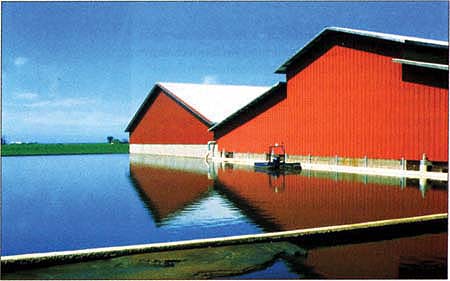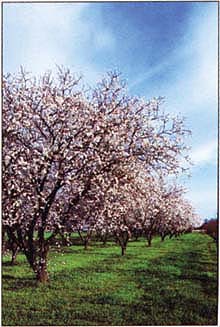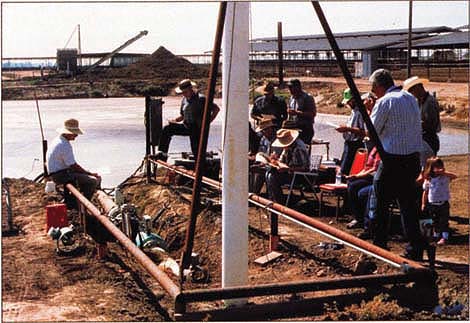All Issues
BIFS reports potential for chemical reductions in crops and dairy
Publication Information
California Agriculture 55(5):10-11.
Published September 01, 2001
PDF | Citation | Permissions
Full text
Biologically Integrated Farming Systems (BIFS) programs are helping growers develop lower-input farming methods for several major commodities. At a Ferndale dairy, an aboveground lagoon holding-pond for manure contains diluted, nitrogen-filled water. Participants in the dairy BIFS program are learning how to use the water as fertilizer for dairy forage crops. Controlled use of manure water can also reduce the potential for groundwater contamination.
UC and other researchers have shown that producers of seven major commodities could potentially reduce dependence on conventional synthetic pesticides and limit the overuse of fertilizers, the UC Sustainable Agriculture Research and Education Program (SAREP) recently reported to California State Legislature.
“The BIFS report documents elimination and large reductions in high-risk agrichemicals in several important production systems,” SAREP director Sean L. Swezey says.
SAREP researchers have been tracking results of the Biologically Integrated Farming Systems (BIFS) program for rice, walnuts, citrus, strawberries, apples, dried plums (prunes) and dairy, in which BIFS farmers voluntarily participate in projects aimed at reducing their use of agricultural chemicals and fertilizers while maintaining economic viability.
Since 1995, SAREP has provided about $2.1 million for BIFS projects in nine crops, with most of the funding coming equally from the California State Legislature and the U.S. Environmental Protection Agency; the UC Division of Agriculture and Natural Resources provided $100,000 in 1997–1998 and has supported the formation of a BIFS workgroup with more than $35,000 for activities through 2003. Each BIFS project is funded for 3 years at approximately $100,000 per year.
The BIFS program is based on the successful Biologically Integrated Orchard Systems (BIOS) model, initiated in 1993 by the nonprofit organization Community Alliance with Family Farmers. In the current issue of California Agriculture, UC researcher Walt Bentley and colleagues report the results of an extensive 3-year comparison of pest levels in almond orchards managed by BIOS and conventional methods ( see page 12 ). Total levels of pest damage were slightly but not significantly higher in the BIOS orchards.
The current walnut BIFS project seeks to extend the successful BIOS model to orchards in the northern San Joaquin Valley.
“Walnut BIFS has reduced nitrogen fertilizer application rates by an average of 53 pounds per acre, with no apparent effect on yield,” Swezey says. “This can help protect groundwater from nitrate pollution.”
The report highlights include:
Dried plum BIFS
During 1999 and 2000, winter applications of the organophosphate insecticide diazinon, an identified threat to water quality, were eliminated in the demonstration/research sites of enrolled farms. Irrigation water use was also reduced on most farms.
Walnut BIFS
The use of pheromone (sex attractant) mating disruption to control codling moth enabled 83% of the enrolled orchards to eliminate the use of organophosphate insecticides in 2000. Use of cover crops increased from 60% in 1999 to 75% in 2000.
Apple BIFS
Pheromone mating disruption in apple orchards decreased the need for organo-phosphates by 59% and carbamates by 92% the first year. The use of all traditional pesticides was reduced in the orchards by 72%.
Rice BIFS
On a per-acre basis, BIFS project growers — who manage more than 14,000 acres — use less than half the amount of herbicides on their entire acreage, compared to county averages.
Dairy BIFS
Data from 11 dairies show it is possible to use manure lagoon water as the primary source of fertilizer for the dairy's forage crop while significantly reducing the use of synthetic fertilizer. Yields obtained this way were similar to yields from fields where commercial fertilizer supplied all or most of the needed nutrients. Controlled use of manure water can reduce contamination of groundwater.
Strawberry BIFS
This project focuses on developing alternatives to the restricted soil fumi-gant methyl bromide, as well as aboveground pests like Lygus bugs. The project has completed the first evaluation of commercially available strawberry cultivars for performance under nonfumigated, certified organic field conditions in California.
Citrus BIFS
Citrus BIFS focuses on reducing use of the herbicide simazine (a known ground-water contaminant), reducing organophosphate insecticide and fertilizer use, and increasing the use of cover crops.
Impacts greatest locally
Each BIFS project has enrolled between eight and 33 farms. Enrolled farms are used for testing new methods, demonstrating proven techniques and hosting field days to extend information about BIFS practices to all growers.
“The BIFS projects use an extension approach that emphasizes a ‘farmer-to-farmer’ method of information sharing, and encourages public-private cooperation,” SAREP associate director Jenny Broome says. “It brings scientists, farmers and consultants together in a collaborative environment that helps participants learn and adapt integrated farming practices to local conditions.”
At the beginning of 2000, 187,153 acres were farmed by BIFS growers in California, about 2.2% of the state's irrigated acreage, SAREP reports. The greatest impacts have been seen at regional or county levels, in particular as a result of the dried plum, walnut and apple BIFS projects.
The BIFS Program Advisory Review Board found that BIFS projects need to focus more on outreach and increase adoption of the environmentally friendly, economically sound BIFS practices. BIFS projects, the SAREP report says, “generally excel at developing and refining the alternative farming practices, but unfortunately this leaves non-BIFS counties without access to new techniques developed by BIFS.”
The BIFS report, “A Progress Report to the California State Legislature on the Implementation of Assembly Bill 3383 and Assembly Bill 1998,” is online at http://www.sarep.ucdavis.edu/BIFS/bifs01/index.htm . Contact SAREP at (530) 752-7556 or sarep@ucdavis.edu.
Early successes with the Biologically Integrated Orchard Systems (BIOS) project in almonds led to the creation of similar BIFS programs for tree fruits and nuts such as walnuts, apples and dried plums.
BIFS projects use an extension approach to sharing information among growers. Field days are a hallmark of the program, which has been funded primarily by the California Legislature and U.S. Environmental Protection Agency. At the Wilbur Brothers Dairy in Tulare County, BIFS project dairy farmers observe a flow-meter demonstration.







